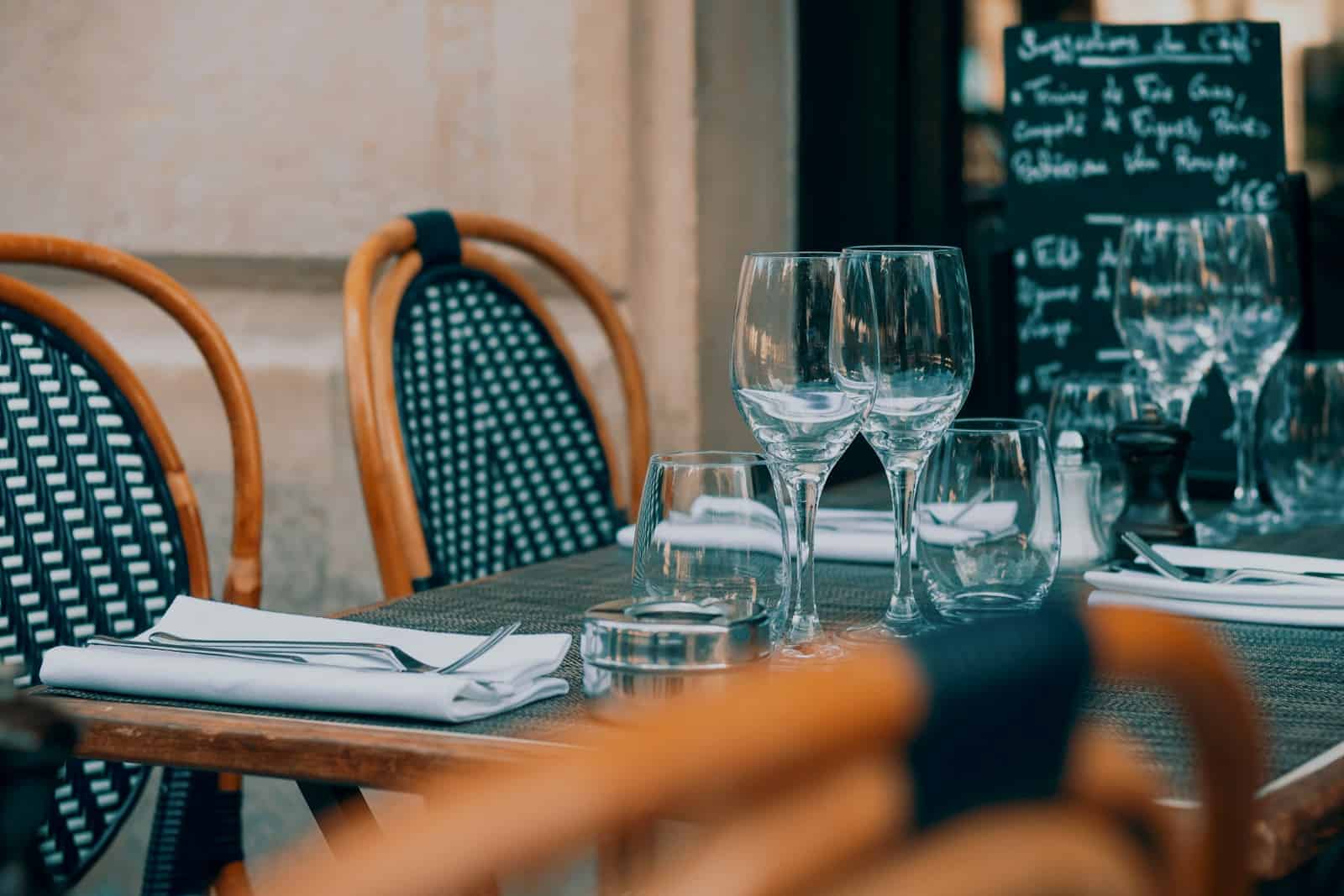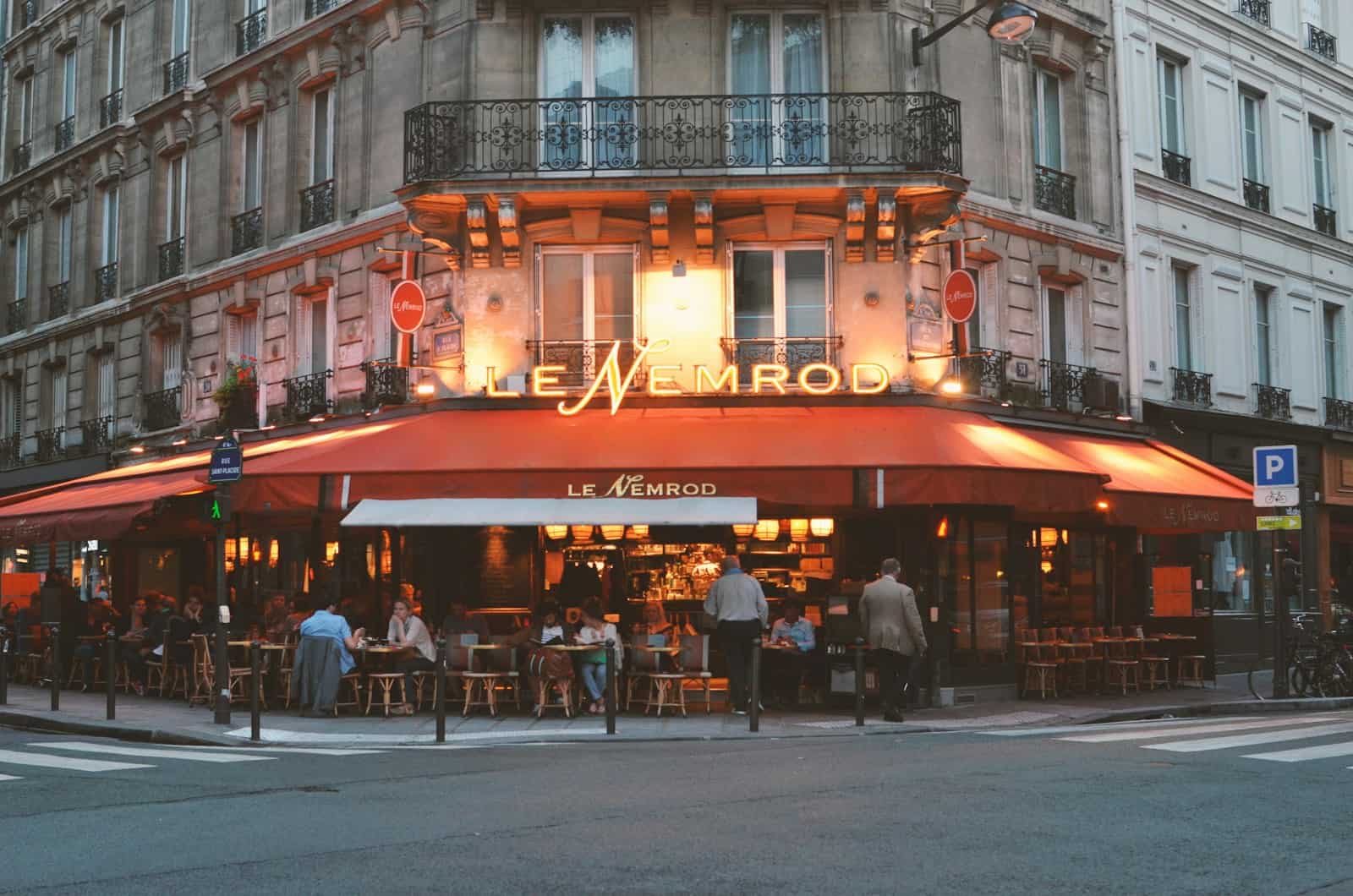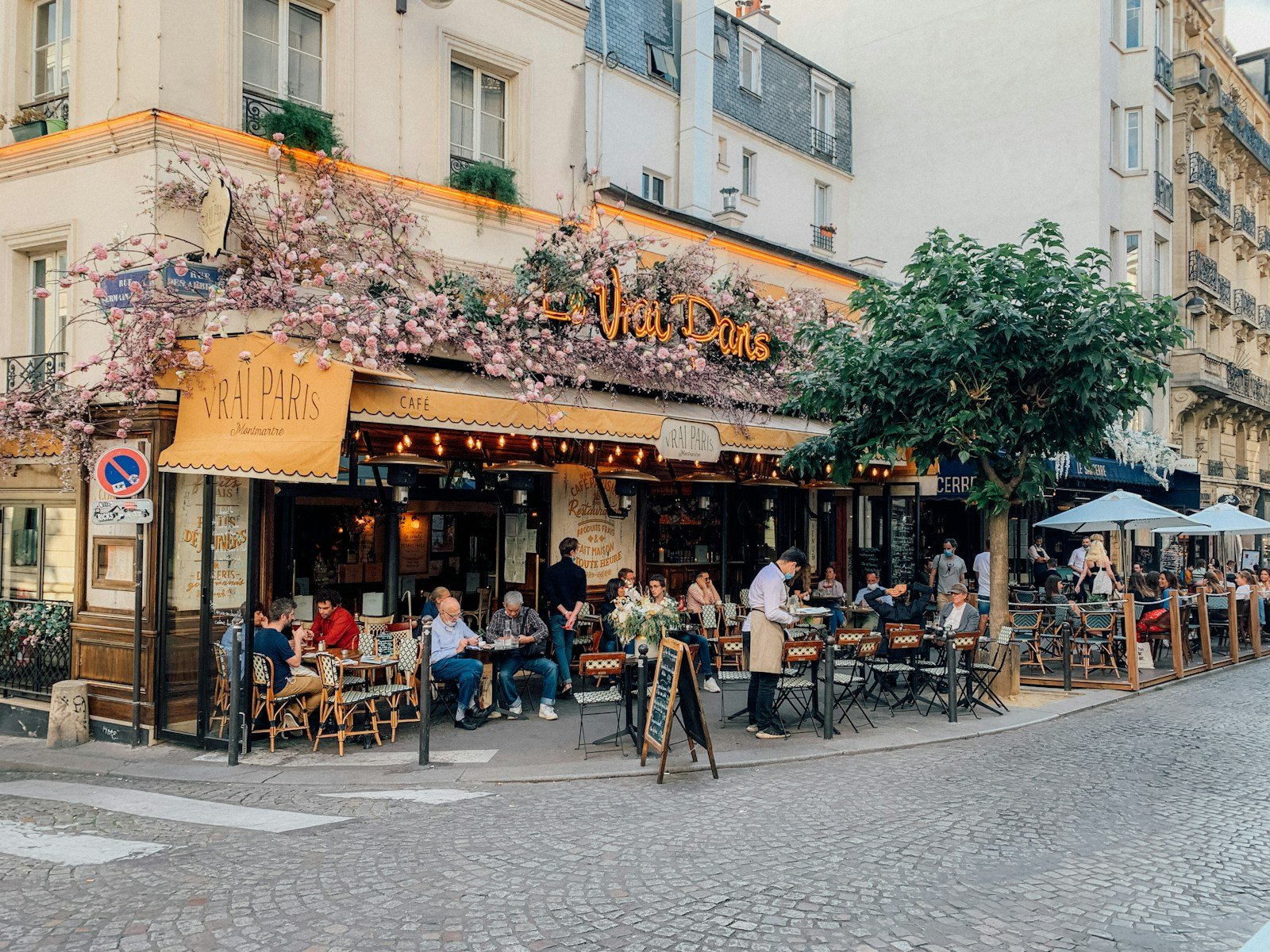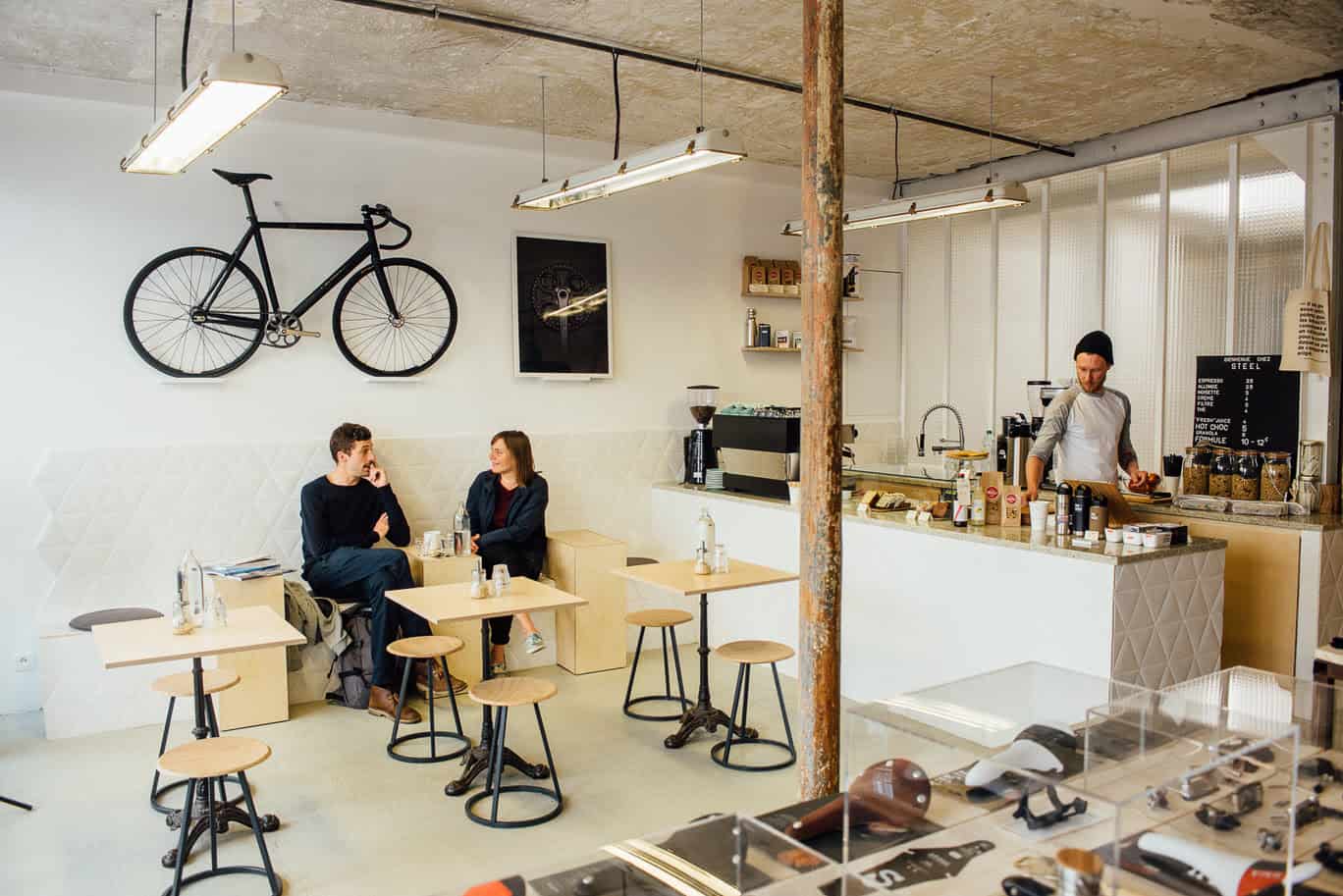Sometimes, I’m still intimidated by Paris. If the city were a person, it would probably be your elegant-but-somewhat-terrifying grandmother. She’ll help you become more refined, but might also scare the heck out of you in the process.
This is especially true at mealtime, and when dining out in Paris, you’ll notice there’s an unspoken code that helps to keep order. If you haven’t quite cracked it yet, don’t be dismayed. Here are some restaurant dining rules to help you fit in with the locals.

Seating
At many cafes and brasseries, seating is a bit of a free-for-all, but there’s no need to feel like a deer in the headlights. Just walk in and don’t forget to greet the host (or whomever seems to be running things). This person should give you an indication of whether you should wait to be seated or whether you can “install yourself” (installez-vous) anywhere.
Dress for success
Super fancy three-star restaurants aside, most eateries in Paris are “casual.” Nonetheless, the French still manage to make casual look cool, neat and discreet. Therefore, ditch the athletic gear, sweatpants, and baseball hats. And when in doubt, layer.
Speak Softly
There’s an unspoken agreement among French diners that if everyone chats quietly, no one will need to shout. (When they want to shout, they head to New York). When in Paris, respect the sound equilibrium and do your best to keep your conversation level low.

Respect the timetable
French kitchens run on a tight schedule. While some restaurants stay open throughout the day and night (look for a service continu sign), many others have explicit opening hours. Lunch is generally served from 12-2:30pm and dinner from 8-10pm. Plan to walk in during these times or, better yet, reserve in advance. Once you’re there, you can generally linger as long as you like.
Bringing the kids
If you’re worried about unanticipated mid-restaurant tantrums, don’t worry—the French have children too. Cafes and brasseries tend to be casual and kid-friendly, and many of them serve continually throughout the day, so you can walk in anytime without a reservation.
Managing your server
Service in Paris ranges drastically from friendly and attentive to negligent and hostile. But in general, waiters are busy and they don’t waste time—yours or theirs—with small talk or unsolicited attention (there’s certainly no “Hey, I’m Jacques and I’ll be your server tonight…”). If you feel you’re being ignored, just wave your server over, or head to the bar to ask for what you need.

Tipping
It’s a perpetually confounding issue for foreigners, but keep in mind that waiters in France don’t “rely” on tips the way they do in other places. Gratuity is included in your bill, but if you’ve had particularly good service, you can leave a small tip (round up or leave a few extra Euros) to show your appreciation.
But most importantly, don’t get so caught up in the rules that you forget to enjoy Paris in all its gastronomic glory. We’ve all made a faux pas or two (or ten)—and managed to eat well just the same. So go forth and be bold!
Restaurant Dining Etiquette in France – How to Dine Like a Local
– Breakfast is not often eaten out by locals (a quick coffee and croissant at the local café will do)
– Normal brunch hours are 11am-3pm.
– Lunch is 12-2:30 pm with most Frenchies showing up at 1 (some restaurants serve until 3).
– Dinner is 8-10 pm. Some restaurants open at 7:30 and some serve until 11 pm or later.
In France, diners don’t always order their entire meal at once. Instead, the waiter will often go around taking appetizer orders first, then go around again for the main course. Only after all food orders have been taken will drinks be ordered. Note: Aperitif orders will be taken upon arrival.
Coffee is not usually served with dessert — it is served after dessert, at the very end of the meal. You can try to get coffee and dessert at once. Good luck. Note: Café gourmand – a coffee and a few small pastries might be the ideal solution!
The French only fill the glass half way. A full glass is simply bad manners. For refills, to French people it does not make sense to put more liquid in a glass that is not almost empty.
These are placed in a similar yet subtly different order to the way we place them in North America. The glasses in France go on the left, whereas in the US it is the right. In the US knives face out and in France they face in. In France, if you find a small spoon and small knife placed above your plate, it means you are all set for cheese and dessert!
In France, tipping is a tricky thing. It is not required, but it is greatly appreciated. If you are happy with the service, a token amount of a few euros or 5-10% of the meal price, depending on the quality of the restaurant, might be in order.
Some French will immediately put their napkin on their lap, and some will not. It has nothing to do with class or education, and you will not be poorly looked upon for not placing a napkin on your knees immediately.
It is not the norm to change your dish by adding things in, taking things out or asking for things that are not on the menu. This could be the single most important difference between North American and French dining etiquette. The French chef has prepared this dish for you with love and put a lot of thought into the end product. The flavors all make sense together. You cannot make any changes without truly vexing the chef, the server and subsequently all of the Frenchies with whom you are dining. In the US the client is king, but in France the chef commands.
When I arrived in France many a year ago, Doggy Bags were taboo. Things have not changed much since. Doggy bag is a word to whisper among friends and ask for only if you are prepared to face scorn and rejection.
Make sure your hands are visible at all times. Otherwise, who knows what you might be doing with them?
If your waiter asks if all is OK they usually don’t really care. From what I can tell asking is a formality for which you are to reply “oui ca va,” but if things are not OK it’s not usually worth mentioning as the waiter probably will not do anything to rectify the problem.
As the concept of tipping is not a necessity, there is less pressure for quick table turnover. In France you may enjoy your meal as long as you wish — your waiter will not want to hurry you out. When you are ready for the check, don’t be shy. Ask. If you are not successful, stand, go to the front of the restaurant and if you are really desperate, make as if you are leaving. Strangely, the check will appear!
RELATED LINKS
- Here’s all you need to know about restaurant and market lingo in France.
- Dinner party rules: here’s all you need to know about dining etiquette in a French person’s home.
- The French cultural rules to live by: find out Tory Hoen’s take on them.
Written by Tory Hoen. Looking to travel? Check out Plum Guide and our Marketplace for fabulous vacation rentals in Paris, France or Italy. Looking to rent long or short term, or buy in France? Ask us! We can connect you to our trusted providers for amazing service and rates or click here. Looking to bring France home to you or to learn online or in person? Check out our marketplace shop and experiences.





RELATED ARTICLES
Summer in Paris: Top Spots to Tan in the City
by
Lory Martinez
Paris’ Best Hidden Gardens
by
Lily Heise
Paris in July 2025: Events, Exhibitions, The Outdoors & More
by
Zoe Adams
Square Spotting: Paris’s Prettiest Squares for Summer
by
Marissa Wu
Moving to Paris: The Reality Behind the Dream
by
Shiva Backhaus
Father’s Day Gifts for Francophiles
by
Zoe Adams
You Can Still Win a Week in Paris
by
Erica Berman
What to do in Paris in June
by
Kathryn Kinley
The Best Croissants in Paris 2025
by
Alessia Armenise
Living, Loving, Learning: Starting a New Life in Paris
by
Marjorie Preval
A Local’s Guide to the 3rd Arrondissement: Life in the Haut-Marais
by
Zoe Adams
Mother’s Day for Francophiles – Last Minute Gifts
by
Caroline Camp
Sweepstakes Alert: Win a Week in a Paris Apartment
by
Erica Berman
Peek-a-boo: Traveling To Paris With Kids
by
Emily Dilling
Paris in May: Things to Do, Weather, Culture, Sports & More
by
Reagan O’Brien
All About the Baguette: The Ten Best in Paris
by
HiP Paris
Rue de Lévis: A Market Street in Paris’s 17th Arrondissement
by
Yvonne Hazelton
What to Wear in Paris in Spring
by
Caroline Camp
Marais Apartment For Sale, Steps From Place des Vosges | Historic Views & Luxury
by
HiP Paris
Paris Like the First Time, Again
by
Bryan Pirolli